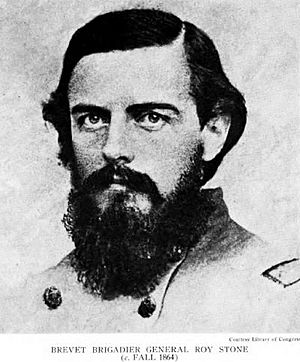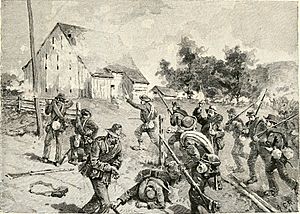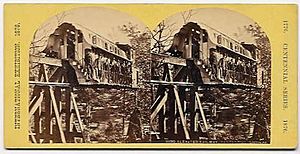Roy Stone facts for kids
Quick facts for kids
Roy Stone
|
|
|---|---|

Roy Stone in the Civil War
|
|
| Division of Public Roads | |
| In office October 3, 1893 – October 13, 1899 |
|
| Preceded by | Position Established |
| Succeeded by | Martin Dodge |
| Personal details | |
| Born | October 16, 1836 Plattsburgh, New York |
| Died | August 5, 1905 (aged 68) Mendham, Vermont |
| Military service | |
| Allegiance | United States of America Union |
| Branch/service | United States Army Union Army |
| Years of service | 1861–1865, 1898 |
| Rank | |
| Commands | 149th Pennsylvania Infantry |
| Battles/wars | American Civil War Spanish–American War |

Roy Stone (born October 16, 1836 – died August 5, 1905) was an American soldier, engineer, and inventor. He fought bravely in the American Civil War, especially at the Battle of Gettysburg. He also served in the Spanish–American War. Later, he worked as an engineer and became the first leader of the Office of Road Inquiry in 1893. This office was an early version of today's Federal Highway Administration, which helps build and maintain roads.
Contents
Early Life and Family
Roy Stone was born in Plattsburgh, New York, a town in New York state. His parents were Ithiel V. and Sarah Stone. His family was among the first people to settle in that area. His father owned a large piece of land. Before the Civil War, Roy worked as an engineer and also in the lumber business.
On August 14, 1862, Roy Stone married Mary Elizabeth Marker. They got married at the First Presbyterian Church in Pittsburgh. Roy and Mary had two children: a son named Richmond and a daughter named Margaret.
Civil War Service
Roy Stone was an officer in the Union Army during the Civil War. He became well-known for his strong defense of the McPherson Farm during the Battle of Gettysburg.
He first served as a major in the 13th Pennsylvania Reserves. This group fought in several early battles, including Antietam. Stone then went back to Pennsylvania to help find new soldiers. In 1863, he became a colonel of the new 149th Pennsylvania Infantry. He led a group of soldiers called a brigade at the Battle of Chancellorsville, but they did not see much fighting there. During the Gettysburg Campaign, Stone continued to lead his three Pennsylvania regiments.
On July 1, 1863, the first day of the Battle of Gettysburg, Stone's brigade was positioned on McPherson's Ridge. This was south of the Chambersburg Pike. Even though his soldiers were new to combat, they were very important in stopping several attacks by the Confederates. Stone moved his regiments to block attacks from enemy leaders. His troops held their ground until other Union groups had to retreat. Stone's men were among the last to leave their area. During the fighting, Stone was badly hurt in his hip and arm. He went home to get better.
After he recovered, Stone returned to duty. He briefly led a brigade in 1864 during Ulysses S. Grant's Overland Campaign. However, he was removed from command during the Battle of the Wilderness. This happened because Stone's horse fell on him on May 5.
Stone then commanded Camp Curtin in Pennsylvania from September 7, 1864, to December 15, 1864. He also led the Alton Military Prison in Alton, Illinois, from December 15, 1864, to January 27, 1865. He left the volunteer army on January 27, 1865.
On December 12, 1864, President Abraham Lincoln suggested that Stone be promoted to brevet brigadier general. This rank would be effective from September 7, 1864. This was for his "brave services during the war, and especially at Gettysburg." The United States Senate approved this promotion on February 20, 1865.
After the War: Engineering and Inventions
After the Civil War, Roy Stone became a strong supporter of the "Good Roads Movement." This movement worked to improve how roads were built and designed. His efforts led to big changes in highway construction. He was one of the first leaders of the Division of Public Roads. He held this position from October 3, 1893, to October 13, 1899.
Among his inventions was a steam-powered monorail. This was shown at the Centennial International Exhibition in Philadelphia in 1876. A bigger version of this monorail was built in 1878 in Pennsylvania, called the Bradford and Foster Brook Railway.
Stone briefly returned to military duty in 1898 as a Brigadier General. He served in the Puerto Rican Campaign during the Spanish–American War.
Later Life and Death
Roy Stone passed away on August 5, 1905, in Mendham, Vermont. He is buried at Arlington National Cemetery, a famous military cemetery.
Honors and Legacy
Stone Avenue in the Gettysburg National Military Park is named after him. This honors his bravery and memory. The palm tree group Roystonea is also named after him. This is because of the road building work he did in Puerto Rico when the island was captured.
See also
 In Spanish: Roy Stone para niños
In Spanish: Roy Stone para niños



